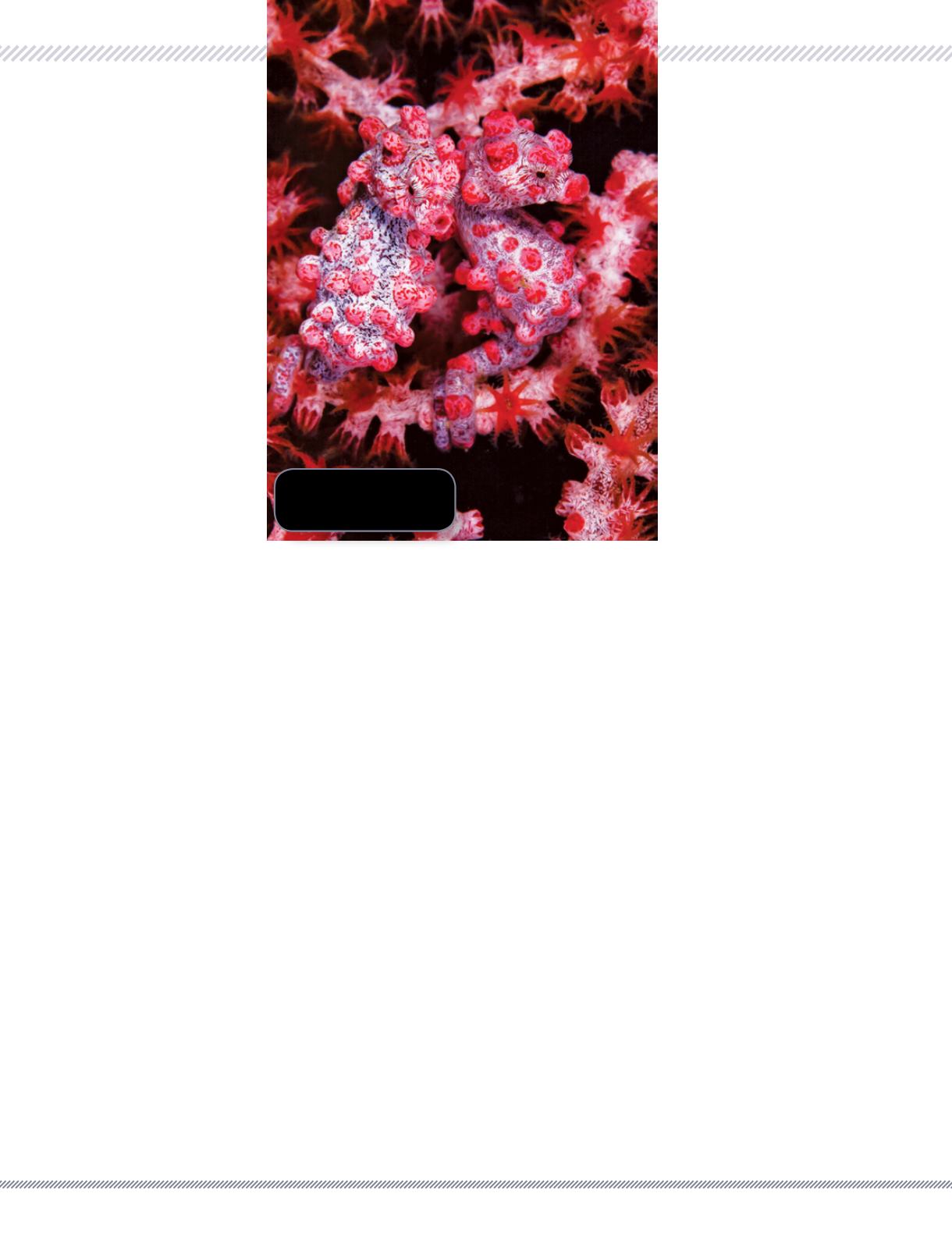
A Title Well Earned
Our trip to the world’s muck-
diving capital was an “off”
visit, or at least that was the
story our dive guide tried to
sell me. Given that I spent
20 minutes photographing
a blue-ringed octopus the
morning after my arrival, I
wasn’t buying it.
Initially the theme seemed
to be shrimp. Commensal
shrimp were absolutely
everywhere: on soft coral,
black coral, nudibranchs,
crinoids, sea urchins, sea
cucumbers and anemones.
I’m quite certain that I could
have found a shrimp living
symbiotically on another
shrimp if I’d looked hard
enough. After a few days our
guide decided that shrimp
were for amateurs. There was not a single hairy frogfish to be
found, and that apparently meant things were slow.
I disagreed. Once I’d gotten my fill of photographing
shrimp, I determined that if the local marine life had been
informed about the “off” nature of our visit, that had only
served to increase their hormone levels. Rampant procreation
was evident, dive after dive. Everything seemed to be either
mating, tending eggs or freshly hatched. Mantis shrimp
held large egg clutches, while mandarinfish paired off in
the water column at dusk. Squid guarded nests on mooring
lines at multiple dive sites. Miniscule juvenile boxfish and
filefish bobbed wide-eyed in front of our cameras, while baby
barrimundi and sweetlips wiggled shyly next to coral heads.
We moved from site to site, logging viewings of fantastic
creatures the likes of which I had only read about: Lembeh sea
dragons! Ambon scorpionfish! A pair of tiger shrimp (again with
the shrimp)! We also saw painted frogfish and warty frogfish,
frogfish the size of a fingernail and frogfish bigger than a cat —
but still no hairy frogfish. Our guide was beside himself.
One afternoon, after a strenuous day of critter overload,
I saw him glumly filling tanks for a night dive. I walked over
and patted him consolingly on the shoulder. I leaned toward
him and quietly revealed my greatest insecurity, a thought
that had haunted me since the second day of our trip.
“Thank goodness this is an ‘off’ visit,” I said. “If it were an
‘on’ visit, I don’t think I could keep up.”
Cephalopod Central
Lembeh tends to attract a goal-oriented crowd. In other
words, it’s not uncommon for visitors to arrive bearing
hopeful suggestions for their
dive guides so they can make
the most of their time spent
looking at the sand. Since
Lembeh’s bizarre underwater
residents change address a
lot, most guest requests don’t
refer to particular sites but
particular creatures. Critter
wish lists are the order of the
day in the strait, and while
they vary, there is one thing
that’s common to nearly all
of them: cephalopods.
Perhaps that’s because this
class of animals, which includes
octopuses, cuttlefish and squid,
singlehandedly showcases
the incredible diversity of
Lembeh. The beautiful-but-
deadly blue-ringed octopus, the
adorable bobtail squid and the
brilliant flamboyant cuttlefish
are all creatures divers wait years to see, and these three species
represent just a small fraction of the cephalopod population that
can easily be viewed within the strait.
Another reason for their popularity might be their
substantial brainpower; these creatures rank among the
Einsteins of the ocean. Cuttlefish seamlessly alter their
coloration to blend with their environment and (it’s thought)
to communicate; coconut octopuses will play peek-a-boo with
observers from their chosen dwelling, be it a coconut shell or
a discarded bottle. If that’s not convincing enough, we refer
you to the mimic octopus, which can hide in the open by
emulating lionfish, sea snakes and other marine animals.
The one disadvantage of the fabulous cephalopod density
in the strait is the inevitability of being lured away from
one species to admire another. Anywhere else, we would be
thrilled to look up from viewing a flamboyant cuttlefish to
discover that we were being closely watched by a broadclub
cuttlefish, but this type of encounter is just a starting point in
Lembeh. A glaring example of this phenomenon took place
during a night dive at
Jahir
, where we spent 90 amazing
minutes moving exclusively from one cephalopod species to
another. That evening’s lineup included a poisonous oscillate
octopus, multiple coconut octopuses, a wonderpus, a starry
night octopus and, as a finale, reef squid in the water column
during our safety stop. Now that’s a wish list.
The Wide World of Lembeh
It isn’t easy to walk away from a sure thing, and Lembeh’s
concentration of incredible small creatures is about as close
to a sure thing as divers may ever experience. After a couple
74
|
FALL 2013
A duo of tiny bargibanti pygmy
seahorses cling to a color-
coordinated sea fan.


